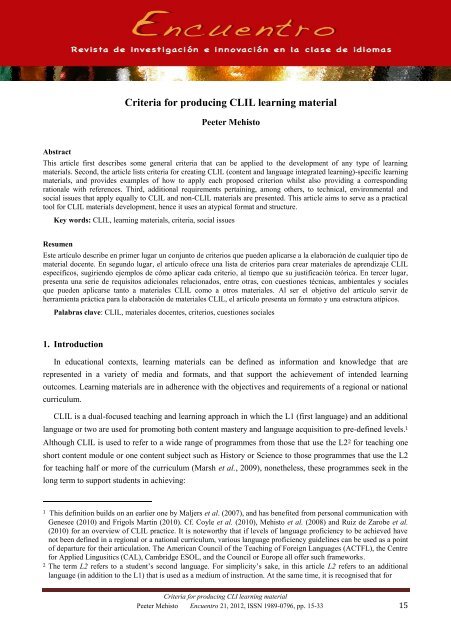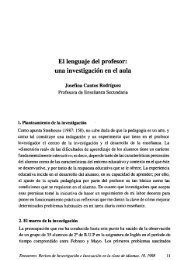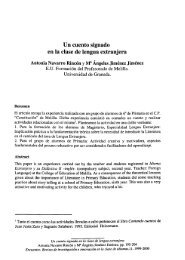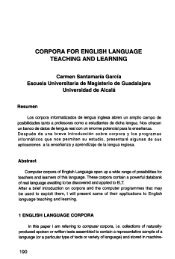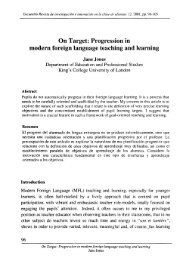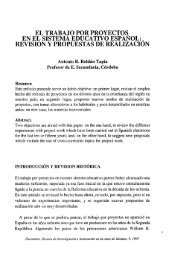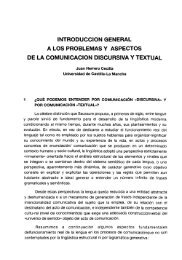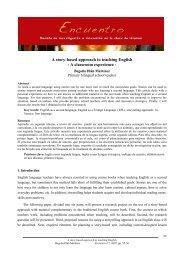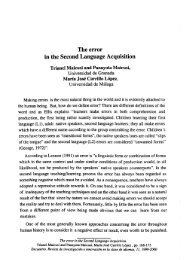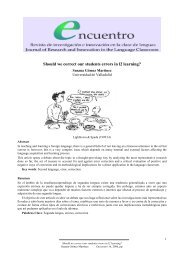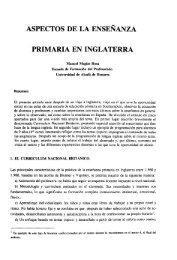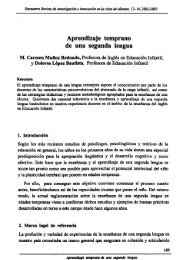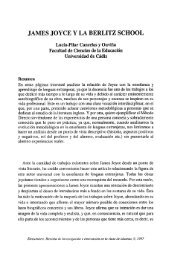Criteria for producing CLIL learning material - Encuentro
Criteria for producing CLIL learning material - Encuentro
Criteria for producing CLIL learning material - Encuentro
You also want an ePaper? Increase the reach of your titles
YUMPU automatically turns print PDFs into web optimized ePapers that Google loves.
ackgrounds making a positive contribution to society. Quality <strong>material</strong>s help students develop medialiteracy, as well as to navigate prejudice and build inclusion.It is important that <strong>learning</strong> <strong>material</strong>s help students to understand their role in the family and othergroupings, and in society at large so that students can make a positive contribution in those contexts. Quality<strong>material</strong>s encourage students to treat others with respect, and promote behaviour that reflects an educated,rational and active sense of responsibility. Quality <strong>learning</strong> <strong>material</strong>s progressively promote students’ senseof belonging and engagement as a citizen of their own country, of supranational organisations such as theEuropean Union, and of the world at large.3. Specific criteria<strong>CLIL</strong>-specific <strong>learning</strong> <strong>material</strong>s support the creation of enriched <strong>learning</strong> environments where studentscan simultaneously learn both content and language, whilst becoming more adept learners of both.Quality <strong>CLIL</strong> <strong>material</strong>s are cognitively highly demanding <strong>for</strong> learners who need to assume the additionalchallenge of <strong>learning</strong> through an L2. However, excessive cognitive load can be avoided by incorporatingenhanced scaffolding and other learner support mechanisms to help students reach well beyond what theycould do on their own. Quality <strong>learning</strong> <strong>material</strong>s help students build a sense of security in experimentingwith language, content, and the management of their own <strong>learning</strong>. In addition, quality <strong>CLIL</strong> <strong>material</strong>s arehighly integrative and multilayered and they help increase the likelihood that both content and language<strong>learning</strong> will be meaningful.The following ten criteria <strong>for</strong> the development of quality <strong>CLIL</strong> <strong>material</strong>s take into account the addedchallenges posed by <strong>CLIL</strong> <strong>for</strong> both the learner and <strong>for</strong> educators, and seek to apply aspects of good pedagogyin a <strong>CLIL</strong>-specific manner. Each of these criteria seeks to maintain a dual focus on content and language.1. Quality <strong>CLIL</strong> <strong>material</strong>s:- make the <strong>learning</strong> intentions (language, content, <strong>learning</strong> skills) & process visible tostudents.For example:Content1. You can name in writing the fifteen major tectonicplates.2. You can explain how tectonic plates affect oneanother.---------------------------------------------------------------------Language3. You can use analogies in scientific descriptions,including explaining their limitations.---------------------------------------------------------------------Learning skills4. You will be able to summarise other students’ ideasmake up the earth’s crust<strong>for</strong>m major tectonic platesto be in constant movementpass each othercollide into each othermove under (on top of) each othermelt into molten rock / become magmarelease gasescause volcanic eruptions----------------------------------------------------------------------------to move as slowly as fingernails growShield volcanoes resemble a Roman soldier’s shield lyingon the ground. They are, however, much wider andtaller.----------------------------------------------------------------------------‘MJ predicts that the next level-seven eruption will occurin Italy in …, because on average there is a level-seveneruption every … years.’NB: It is important to break intended <strong>learning</strong> down into short and long-term planned outcomes that areincorporated into <strong>learning</strong> <strong>material</strong>s. Furthermore, quality <strong>CLIL</strong> <strong>material</strong>s draw links between planned short andlong-term language, content and <strong>learning</strong> skills outcomes. It is also expected that <strong>learning</strong> outcomes are realistic,but challenging.<strong>Criteria</strong> <strong>for</strong> <strong>producing</strong> CLI <strong>learning</strong> <strong>material</strong>Peeter Mehisto <strong>Encuentro</strong> 21, 2012, ISSN 1989-0796, pp. 15-33 17
Rationale:Marzano (1998: 127) and Hattie (2009: 246, 2012: 47-49) both argue that setting clear instructionalgoals <strong>for</strong> students, and providing feedback on how students are progressing towards these have apowerful effect on student <strong>learning</strong>, as well as on improving cognition and student achievement. Woodet al. (1987) found that challenging goals significantly increased <strong>learning</strong>. For students to be able toachieve a <strong>learning</strong> goal, they need to first know and understand that goal (Black et al. 2004: 14). In thedomain of language <strong>learning</strong> both Gardner (1985) and MacIntyre (2002) argue that visible goals arecentral to building and maintaining learner motivation.2. Quality <strong>CLIL</strong> <strong>material</strong>s:- systematically foster academic language proficiency.For example:Scientific language is drawn to the attention of students by identifying its various component parts inthe <strong>learning</strong> <strong>material</strong> or by asking students to identify within the <strong>material</strong>s: its characteristics (tone,unemotional and factual, evidence-based vs personal opinion); its functions (separating and explainingcauses and consequences); connectors <strong>for</strong> comparing and contrasting (however, but, on the other hand,in contrast, in the same way, conversely, on the contrary); subject-specific vocabulary (sternum vsbreastbone); words with different meanings (omnivore vs animal that eats all kinds of food); and othersubject-specific vocabulary and discourse patterns. In addition, key structures, terminology, phrases andsets of phrases can be highlighted.As academic language is often decontextualized (little in<strong>for</strong>mation about context, and meaning isconveyed primarily by linguistic clues), <strong>CLIL</strong> <strong>material</strong>s can provide additional contextual in<strong>for</strong>mationto help students to process the language. Also, as academic language is more precise than the languageused <strong>for</strong> social discourse, <strong>CLIL</strong> <strong>material</strong>s can contrast both of these types of language to make themvisible to students.Content subject <strong>material</strong>s can include intended language outcomes to foster ongoing, step-by-stepgrowth in a student’s use of academic language. Short-term language outcomes are linked to long-termoutcomes so students can better see the progress they have made and what still remains to be learned.Rationale:For students to develop academic language proficiency a systematic ef<strong>for</strong>t is required by educators andstudents across Grade levels (Cloud et al. 2000: 14). In general, it is thought that it takes about 4-7years <strong>for</strong> immigrant students in English speaking environments to develop academic languageproficiency (Hakuta 2000: 10: Cummins 2000: 586). Faced with teaching challenging academic contentto students who are far from proficient in their L2, teachers could resort to task reduction andsimplification. Cummins (2007: 126) 7 warns that if teachers make student tasks cognitively easier than<strong>for</strong>eseen in the curriculum, they may inadvertently trap students in an impoverished <strong>learning</strong>environment, where they will not be able to learn the language and content they need <strong>for</strong> academicsuccess. Quality <strong>material</strong>s that help draw attention to the component parts of academic language andtheir use, act as a scaffold <strong>for</strong> content teachers who may also find it challenging to identify and teachthe language of their subject.7 Cf. Cummins (2007: 126) referring to Mackay (1992: 162-163).<strong>Criteria</strong> <strong>for</strong> <strong>producing</strong> CLI <strong>learning</strong> <strong>material</strong>Peeter Mehisto <strong>Encuentro</strong> 21, 2012, ISSN 1989-0796, pp. 15-33 18
3. Quality <strong>CLIL</strong> <strong>material</strong>s:- foster <strong>learning</strong> skills development and learner autonomy.For example:Prior to a challenging text, a <strong>learning</strong> <strong>material</strong> could contain a think-pair-share exercise requiringstudents to brainstorm ways of coping with the language and/or the content in a difficult text. Or, in asimilar context, the <strong>learning</strong> <strong>material</strong> can guide students through a research exercise to find 10 ways ofcoping with the language and/or content in difficult texts. Or, it could include a pre-readingassignment asking students to skim or scan a text <strong>for</strong> unfamiliar words and to guess their meaningprior to reading. Or the <strong>material</strong> could ask students to read a text several times <strong>for</strong> different purposessuch as once <strong>for</strong> analysing some aspects of language, and a second time to find three key ideascontained therein.A book chapter can, right at the beginning include an initial exercise that asks students questionsabout the given chapter’s subheadings and diagrams or that asks students to first read the conclusionand to speculate on what is behind key conclusions.Instead of simply giving a research assignment to students, <strong>learning</strong> <strong>material</strong>s can ask students to firstplan <strong>for</strong> undertaking and writing up the research report.Materials can also include <strong>learning</strong> skills tips on how to efficiently complete an assignment.Materials can seek to help students determine what they think and feel, as well as provide some levelof choice.Rationale:Marzano (1998: 112) states that ‘metacognition drives <strong>learning</strong>’ pointing to the need to help studentsto step back from an activity and analyse their thinking processes. In situations where students arefaced with intellectually challenging tasks, Veenman et al. (2002: 337) 8 found that meta-cognitiveskills are a greater determinant of student achievement than intellectual ability as measured by IQtests. Watkins (2005: 80) 9 reports on a study that reviewed GCSE 10 examination results in England,and found that students who ‘plan the least have just 30 per cent of the scores of pupils who plan themost.’Hattie (2012: 103) stresses that although some simple strategies such as mnemonics can be taughtoutside a content domain, ‘most strategies have to be taught within the content domain’.Arnau (1998: 95) 11 sees the teacher as a mediator of <strong>learning</strong> who gradually yields control over thelanguage <strong>learning</strong> process to learners themselves who are intrinsically motivated. Students’ intrinsicmotivation or inner motives are undermined when teachers are controlled-oriented, as theirinstructional agenda ‘defines what students should think, feel, and do’ (Reeve et al., 2004: 148).Reeve et al. (2004: 165) found that the more teachers display ‘autonomy-supportive instructionalbehaviors, the more engagement their students [show].’ Similarly, Deci et al. (1982: 859) argue thatcontrolling environments are likely to ‘impair <strong>learning</strong>’ while ‘intrinsic motivation improves<strong>learning</strong>.’In the field of language <strong>learning</strong> numerous scholars argue that students need to be supported inbecoming autonomous learners (Holec, 1981; Kohonen, 2009; Little, 2008). Knouzi et al. (2010: 24)propose that language learners self-scaffold their own <strong>learning</strong> developing a <strong>for</strong>m of ‘private speech’referred to as ‘languaging’ so they can better manage their own thinking about and <strong>learning</strong> oflanguage. Similarly, Edmonson (2009: 178) posits that ‘good language learners’ are aware ofthemselves and of how they learn language: they regularly analyse ‘grammar, and constantly look <strong>for</strong>patterns and regularities’ and ‘analyse the target language as a means of communication, they monitortheir progress. They are in a word ‘active’ learners.’ Ox<strong>for</strong>d (2011: 5) suggests that developing metacognitive,meta-affective and meta-social strategies plays a central role in helping the language learnerto take charge of his or her <strong>learning</strong>.8 Based on initial inductive <strong>learning</strong> with a complex computer simulation.9 Cf. Watkins (2005: 80) referring to Atkinson (1999).10 General Certificate of Secondary Education11 Cf. Arnau (1998: 95) referring to Moll (1989).<strong>Criteria</strong> <strong>for</strong> <strong>producing</strong> CLI <strong>learning</strong> <strong>material</strong>Peeter Mehisto <strong>Encuentro</strong> 21, 2012, ISSN 1989-0796, pp. 15-33 19
4. Quality <strong>CLIL</strong> <strong>material</strong>s:- include self, peer and other types of <strong>for</strong>mative assessment.For example:Quality <strong>CLIL</strong>-content <strong>material</strong>s at various points include reflection on and assessment of thefollowing: achievement of content and language goals (planned outcomes); achievement of <strong>learning</strong>skills goals; use of language <strong>for</strong> various purposes (i.e., academic, social, business registers); ability towork with authentic <strong>material</strong>s, as well as with native and non-native speakers of the <strong>CLIL</strong> language;willingness to experiment with content and language; ongoing growth of language (avoiding‘plateauing’).If a textbook contains an assignment (e.g., a project), the steps of the assignment can include havingstudents develop content and language (self, peer, teacher) assessment criteria <strong>for</strong> the final product ofan assignment. This could also include having pairs of students revisit their peer assessments afterstudents receive the teacher’s assessment. Materials can also build in assessments of drafts prior towork being handed in <strong>for</strong> a final grade, as the feedback from these assessments has an outlet <strong>for</strong>immediate application thus helping to increase the possibility that it will be taken into account (that itwill be <strong>for</strong>mative).As well, a textbook can ask students to measure language growth over time by encouraging them toplot their marks and needed <strong>learning</strong> on a grid. Students could then be asked to draw conclusions, settargets, and develop plans <strong>for</strong> meeting those targets.Rationale:Assessment is seen as pivotal <strong>for</strong> <strong>learning</strong>. The British Qualifications and Curriculum Authority (QCA)deems assessment as ‘central to classroom practice’ (2007). Materials that do not include assessmentdecrease the likelihood that assessment will be used in an optimal manner as a tool <strong>for</strong> <strong>learning</strong>. TheQCA also points to the need <strong>for</strong> students to learn about how <strong>learning</strong> takes place and <strong>for</strong> assessment tobe constructive taking into account the emotional impact of comments, marks and grades.‘Assessment <strong>for</strong> <strong>learning</strong> is any assessment <strong>for</strong> which the first priority in its design and practice is toserve the purpose of promoting students’ <strong>learning</strong>’ (Black et al. 2004: 10). When teachers andstudents use feedback from assessment in assessing themselves and each other that assessment isdeemed to be <strong>for</strong>mative assessment if both use that evidence to improve their practices (ibid.). In theirreview of over 250 research articles Black and Wiliam (2010: 82) conclude that assessment <strong>for</strong><strong>learning</strong> significantly improves student achievement and raises standards of education. Althoughothers feel more evidence is required to prove the cause and effect relationship between assessment<strong>for</strong> <strong>learning</strong> and student achievement, there is general agreement that it helps to improve teachingpractice, and student attitudes and engagement in <strong>learning</strong> (Stobart 2008: 155; Hattie 2012: 126referring to Yeh 2011).5. Quality <strong>CLIL</strong> <strong>material</strong>s:- help create a safe <strong>learning</strong> environment.For example:Materials can foster ‘cognitive fluency’ 12 by avoiding cognitive overload. When challenging contentconcepts are being introduced, an additional measure of language scaffolding is provided to allow thestudent to focus primarily on understanding the concepts. In<strong>for</strong>mation and assignment are generallybroken into smaller chunks than might be the case with L1 <strong>material</strong>s. Materials provide appropriatenavigation support such as advance organisers.Materials avoid sarcasm and ridicule. Materials are respectful of diversity and foster inclusion.Materials foster meta-affective awareness by asking students questions about how certain exercises orassignments make them feel, and suggest coping strategies.12 Unkelbach (2006: 339) states that ‘cognitive fluency is the experienced ease of ongoing conceptual or perceptualcognitive processes.’<strong>Criteria</strong> <strong>for</strong> <strong>producing</strong> CLI <strong>learning</strong> <strong>material</strong>Peeter Mehisto <strong>Encuentro</strong> 21, 2012, ISSN 1989-0796, pp. 15-33 20
Rationale:The Organisation <strong>for</strong> Economic Co-operation and Development (OECD 2007: 154) in its reportentitled Understanding the Brain stresses the interdependence of emotion and cognition. The reportargues that ‘[e]specially important <strong>for</strong> educational purposes is the analysis of fear and stress, whichshows how they, <strong>for</strong> instance, reduce analytical capacity, and vice versa how positive emotions opendoors within the brain’ (ibid.). This is in line with Bruner’s (1996: 25) view that education needs toprovide skills <strong>for</strong> dealing with feelings. In authentic <strong>learning</strong> environments people feel safe, andpositive emotions hold the potential of enhancing <strong>learning</strong>. In bilingual education, it is particularlyimportant <strong>for</strong> students to feel free to experiment with the L2 and challenging content without the fearof making mistakes. 13 Mehisto et al. (2008: 105) concur, and draw a link between creating a safe<strong>learning</strong> environment and high expectations <strong>for</strong> all stating that is paramount <strong>for</strong> teachers to believe thatall of their students will succeed and to make this belief visible to each student.6. Quality <strong>CLIL</strong> <strong>material</strong>s:- foster cooperative <strong>learning</strong>.For example:Materials structure peer cooperative work so as to foster: positive interdependence; face-to-faceinteraction; individual and group accountability; interpersonal and small-group skills; and groupprocessing (Johnson et al., 1998).In a <strong>CLIL</strong> context, <strong>learning</strong> <strong>material</strong> would provide some of the language needed <strong>for</strong> doing peercooperative work such as terminology and sets of phrases required to manage group work, to fostercritical thinking and to test and analyse group work results.Learning <strong>material</strong>s can build in an assessment grid <strong>for</strong> students to evaluate mid-assignment or uponcompletion how effectively their group is or has been working to achieve planned outcomes. Thismight include criteria about amount of <strong>CLIL</strong> language used during group work.Rationale:Johnson and Johnson (2002: 103) who conducted a meta-analysis of research studies into cooperative<strong>learning</strong> found that when compared to individualistic <strong>learning</strong>, cooperative <strong>learning</strong> had a high effectsize of 0.64 on student achievement. The effect size of cooperative <strong>learning</strong> on achievement was twicethat of the effect size <strong>for</strong> competitive <strong>learning</strong>, and cooperative <strong>learning</strong> was also found to buildstudent self-esteem. Similarly, Roseth et al. (2008) in a review of 148 independent studies coveringeight decades and 11 countries found very similar results.Goldenberg (2008: 13), who reviewed five meta-studies on language <strong>learning</strong>, stresses that effectiveinstruction provides ‘ample opportunities to use the second language in meaningful and motivatingsituations.’ Peer cooperative work is one key way of creating such opportunities. Coyle et al. (2010:37) who also stress the value of cooperative <strong>learning</strong> in <strong>CLIL</strong> contexts, concomitantly call <strong>for</strong>educators to provide students with both the ‘language of <strong>learning</strong>’ and the ‘language <strong>for</strong> <strong>learning</strong>’ withthe <strong>for</strong>mer consisting of the ‘language needed <strong>for</strong> learners to access basic concepts and skills relatingto the subject theme or topic’ and the latter consisting of the ‘language needed to operate in a <strong>for</strong>eignlanguage environment’ to engage, <strong>for</strong> example, in group work, debate or enquiry.13 Cf. Boynton (2005: 89); Carmody (2005: 60).<strong>Criteria</strong> <strong>for</strong> <strong>producing</strong> CLI <strong>learning</strong> <strong>material</strong>Peeter Mehisto <strong>Encuentro</strong> 21, 2012, ISSN 1989-0796, pp. 15-33 21
9. Quality <strong>CLIL</strong> <strong>material</strong>s:- foster cognitive fluency through scaffolding of a) content, b) language, c) <strong>learning</strong>skills development helping student to reach well beyond what they could do on theirown.For example:Language can be scaffolded by: repeating new nouns as opposed to using pronouns; shorteningsentences and paragraphs; inserting synonyms in parentheses; providing explanations of some keyvocabulary and expressions in the margins; asking students to first brainstorm related language;grouping language according to use (e.g., procedures, equipment, personal attitudes); presentingin<strong>for</strong>mation in two side-by-side boxes using two different registers of language; embedding electronicpronunciation and dictionary links <strong>for</strong> difficult terms; using wordsmyth.com or wordchamp.com.Content can be scaffolded by: helping students in an introductory paragraph or assignment to accesstheir tacit knowledge and to connect the topic to their lives; providing an advance organiser; usingother graphic organisers such as Venn diagrams, tables and charts; avoiding compound sentences;shortening paragraphs; highlighting or underlining key ideas or facts; using plenty of subheadings;providing sample answers or exemplars of good work; showing what falls outside of a concept, as wellas what it includes; providing electronic links to animations.Learning skills can be scaffolded by: providing a sample correct answer at the start of an exercise;spotlighting samples of well done student work; providing a commented sample of poorly donestudent work; including planning, monitoring and evaluation tasks; asking students to guess meaningfrom context; providing electronic samples of recasting and error correction techniques.Rationale:Scaffolding ‘leads learners to reach beyond what they are able to achieve alone, to participate in newsituations and to tackle new tasks’ (Gibbons 2002: 8). Research from the neurosciences shows thatwhen initially faced with a cognitively challenging problem the brain needs to bring considerableresources to bear in order to solve it (Howard-Jones, 2007: 17). Students in <strong>CLIL</strong> contexts face theadditional challenge of <strong>learning</strong> through an L2 and as such require additional scaffolding (Walqui2006: 169-178) to avoid cognitive overload. Walqui (ibid.: 169-178) proposes scaffolding strategies<strong>for</strong> <strong>CLIL</strong> such as modelling (providing examples <strong>for</strong> imitation), bridging (building on previousknowledge and understandings), contextualising (adding context to academic language), schemabuilding (providing thinking frameworks such as charts or advance organisers), re-presenting text(using a new genre to present the same content), and developing meta-cognition (building <strong>learning</strong>skills strategies such as planning, monitoring, and evaluating).The ultimate goal of scaffolding is to support students in becoming self-directed learners who can seekout resources and people to support them in their ongoing <strong>learning</strong>. Knouzi et al. (2010: 23-24)suggest that students use ‘languaging or self-explaining […] to intentionally organize and control theirmental processes during the per<strong>for</strong>mance of cognitively complex tasks.’ Knouzi et. al. (ibid.: 23)consider ‘languaging’ a <strong>for</strong>m of self-scaffolding. Although some learners are more adept than others atusing this <strong>for</strong>m of self-scaffolding skill, ‘with supportive teaching [it] can be made available to mostlearners’ (ibid.: 47).<strong>Criteria</strong> <strong>for</strong> <strong>producing</strong> CLI <strong>learning</strong> <strong>material</strong>Peeter Mehisto <strong>Encuentro</strong> 21, 2012, ISSN 1989-0796, pp. 15-33 24
10. Quality <strong>CLIL</strong> <strong>material</strong>s:- help to make <strong>learning</strong> meaningful.For example:Quality <strong>material</strong>s help explain the relevance of intended <strong>learning</strong>. They ask students to explain how intended<strong>learning</strong> is tied to their lives by asking specific questions about how this <strong>learning</strong> can be used by them or byothers in the community.Materials seek to connect intended <strong>learning</strong> with students’ interests, their lives and theircommunity/communities. They make connections to previous <strong>learning</strong> when presenting new facts andconcepts. They seek to deepen previous <strong>learning</strong>.Materials draw cross-curricular links and incorporate cross-curricular projects.Materials foster cooperative <strong>learning</strong>, visualisation and hands-on activities. They offer students choice, andsome control over the <strong>learning</strong> process.Materials focus on fostering critical thinking including applying, analysing, evaluating and creating. This isapplied to language, content and <strong>learning</strong> skills.Rationale:When faced with new in<strong>for</strong>mation the ‘brain immediately begins a filtering process to determine which dataare relevant’ and what should be discarded (Westwater and Wolfe 2000: 49). Connections are at the root ofrelevance. Howard-Jones (2007: 18) argues that meaning is physically constructed in the brain so that‘[w]hen we learn new in<strong>for</strong>mation, the links that <strong>for</strong>m between this new in<strong>for</strong>mation and our existingknowledge serve to make it meaningful.’ Howard-Jones (ibid.) argues that this is central to understandingand recall of in<strong>for</strong>mation. Petty (2006: 235) states that ‘relational links are the glue that fixes <strong>learning</strong> in thememory.’ Making connections in a classroom can involve helping students to access their currentknowledge, understandings, attitudes and <strong>learning</strong> skills, part of which may be tacit. To build relationallinks, several practitioners and researchers suggest teachers in bilingual education organise the ‘curriculumaround content-based thematic concept(s)’ (Fortune 2000: 2-4). 17 Baker (2006: 344) considers classroom‘cross-curricular approaches’ as a requirement <strong>for</strong> promoting biliteracy development. In addition, Howard-Jones (ibid.) points to the power of visualisation. Doidge (2007: 201-204) 18 documents several cases wherevisualisation has helped improve per<strong>for</strong>mance in sport or helped someone to learn to play the piano.Drawing on the National Assessment <strong>for</strong> Educational Progress study of 9-year olds in the United States andthe Programme <strong>for</strong> International Student Assessment (PISA) scores <strong>for</strong> 15-year olds from 32 countries,Guthrie (2004: 5) argues that students:whose family background was characterized by low income and low education, butwho were highly engaged readers, substantially outscored students who came frombackgrounds with higher education and higher income, but who themselves were lessengaged readers. Based on a massive sample, this finding suggests the stunningconclusion that engaged reading can overcome traditional barriers to readingachievement, including gender, parental education, and income.Guthrie (2004: 10) goes on to state that a meaningful topic and text, sufficient time as well as ‘students’ selfdirection,and collaborative social structures […] are indispensable to engagement in reading.’ Guthrie(2004: 3) also describes engagement as including thinking critically about the text, writing about it, andusing <strong>learning</strong> strategies to cope with the text and gain new knowledge from it. A collaborative socialstructure provides opportunities to discuss reading and make it more meaningful. Self-direction is a <strong>for</strong>m ofempowerment. Writing about one’s reading would likely enhance meaning helping to deepen understanding.In fact, without explicitly stating it, Guthrie proposes linking all four language skills when analysing a giventopic and text.Meaningful <strong>learning</strong> also fosters learner autonomy. Fischer (2009: 5-6) puts <strong>for</strong>th that:[w]hen we actively control our experience, that experience sculpts the way that ourbrains work, changing neurons, synapses, and brain activity. 19 When we are simplyexposed to events and in<strong>for</strong>mation (as opposed to acting on them), our brains andbodies are not much affected.17 Cf. also Boynton (2005).18 Cf. Doidge (2007: 201-204) referring to Pascual-Leone et al. (1995), Yue and Cole (1992).19 Cf. Fischer (2009: 5) referring to Hubel and Wiesel (1970), Singer (1995).<strong>Criteria</strong> <strong>for</strong> <strong>producing</strong> CLI <strong>learning</strong> <strong>material</strong>Peeter Mehisto <strong>Encuentro</strong> 21, 2012, ISSN 1989-0796, pp. 15-33 25
4. Other requirements: IntroductionAlthough not specific to <strong>CLIL</strong>, the following requirements, issues and criteria need to be taken into accountby those developing CIL <strong>material</strong>s so as to ensure that they con<strong>for</strong>m to the general norms of publishedstudent <strong>learning</strong> <strong>material</strong>s.5. Technical requirements1. Printed <strong>learning</strong> <strong>material</strong>s must con<strong>for</strong>m to the technical requirements set by local or national educationauthorities, including that they must be large enough <strong>for</strong> a child to hold com<strong>for</strong>tably, con<strong>for</strong>m to weighlimits and use required font sizes.2. In kindergarten block letters should be used. No emphasis is to be marked on syllables.3. Art styles and colours within a page or on facing pages should not conflict with one another.4. Electronic <strong>material</strong>s must con<strong>for</strong>m to the technical requirements set by local or national educationauthorities, including ensuring that they also foster face-to-face communication with others, that theydirect students to non-electronic sources of <strong>learning</strong>, that they meet navigability and safetyrequirements, that they help students to assess and regulate their use of electronic media, and that theyfoster the development of media literacy.5. Environmental issuesTransportation should draw attention to environmental sustainability. Preference is given to publictransportation as opposed to large cars and sport utility vehicles, especially with only one occupant unlessattention is drawn to that occupant’s carbon footprint.1. People should also be shown walking or riding a bicycle to reach their destinations safely (e.g., riding abicycle that has lights and reflectors while wearing a helmet).2. Preference is given to depicting situations which reflect an average standard of living. Subject matterand illustrations should avoid focusing on objects which suggest great wealth (luxury yachts, privatehelicopters and jets, expensive jewellery) or abject poverty, unless they are subject to analysis and usedin direct support of meeting intended <strong>learning</strong> outcomes.3. Not only should consideration be given to reflecting the current level of technological development, butevery ef<strong>for</strong>t should be made to take into account projected trends such as the ever-increasing andinnovative use of communications and medical technologies.4. The environment and human activity should demonstrate respect <strong>for</strong> plants as living things, regardlessof whether they are cultivated or growing in the wild. The same should be done in the case of domestic,domesticated and wild animals. Regulations regarding endangered species must be respected.5. City, suburban and rural life should not be idealised or glamorised, and a balance of different settingsshould be used.6. When depicting urban areas, special attention should be paid to presenting them as healthy, peoplefriendlyenvironments <strong>for</strong> both children and adults, unless analysis of a failing urban setting is part ofthe intended <strong>learning</strong>.7. Where appropriate, text and illustrations should reflect the growing emphasis on reducing consumption,reuse, recycling, renewable energy and the use of local products.<strong>Criteria</strong> <strong>for</strong> <strong>producing</strong> CLI <strong>learning</strong> <strong>material</strong>Peeter Mehisto <strong>Encuentro</strong> 21, 2012, ISSN 1989-0796, pp. 15-33 26
8. Social issuesA. The elderly1. Elderly women and men should generally be depicted as having healthy, dignified and rich lives, unlessa contrary depiction is clearly tied to a lesson to be learned.2. Elderly people should not be arbitrarily depicted in unfashionable clothing or as having unfashionablehairstyles and accessories. Stereotypes such as grey hair, canes, wire-rimmed glasses and rocking chairs,etc. should not dominate.3. Middle-aged and elderly persons should be depicted actively engaged with younger generations. Groupsof people should be made up of people of different ages unless the depiction of one specific age groupserves a particular purpose.4. Elderly persons should be depicted as involved in many activities which are beneficial to society and theenhancement of their own lives.B. The Physically Challenged1. Physically challenged persons should be depicted as part of the group involved in the mainstream ofevents, and subject matter should include their lifestyles and achievements. They should also be seen ina leadership role.2. Physically challenged children and adults should be depicted in various environments and interactingwith other people.3. The ability of the physically challenged to cope with everyday life and to adapt to the environmentshould be shown.C. Minorities1. Photographs and illustrations should convey the ethnic diversity of the region/country.2. Minorities should be depicted as having social status equal to that of the majority.3. The names and personalities of characters should reflect a diversity of cultures and social tolerance.4. Illustrators should bear in mind that not all members of an ethnic group look alike, but rather thatphysical characteristic vary widely. Portraits of any ethnic group, be it Roma, Koreans, Georgians,Nigerians, Uzbeks or Tartars, should be realistic and recognisable. People of various ethnicbackgrounds should be depicted wearing modern day typical dress, and not placed in national costumeswithout just cause.5. Exaggerations, which often lead to distortion of physical characteristics, should be avoided. Physicalfeatures common to people of certain racial groups should be depicted realistically.6. Illustrations should promote a positive self-image <strong>for</strong> people of all ages and ethnic groups. Leadershiproles in various activities and professions should be divided proportionately among members ofdifferent ethnic groups.7. When depicting skin colour, artists should make sure that the skin colour is the same once printed, andthat it is the same each time <strong>for</strong> characters that are used repeatedly. Skin tone may vary among membersof the same family.8. Skin tone may be omitted from black and white illustrations if the distinctive features of the ethnicgroup can be depicted in some other way.<strong>Criteria</strong> <strong>for</strong> <strong>producing</strong> CLI <strong>learning</strong> <strong>material</strong>Peeter Mehisto <strong>Encuentro</strong> 21, 2012, ISSN 1989-0796, pp. 15-33 27
9. Reference to stereotypes regarding social and economic circumstances should be avoided, unless theyare portrayed in a historical context, and accompanied by text that helps the reader interpret the givenillustration.10. The cultural contribution and distinctive lifestyles of ethnic groups (such as travellers) should bedepicted in a positive, culturally tolerant way.D. Gender equality1. Teaching <strong>material</strong>s should portray a balance of men/boys, and women/girls in active roles and differentage groups. Generally a ratio of 50:50 should be adhered to in both content and illustrations.2. Both sexes should be depicted as being engaged in independent activities, as well as in leadership roles.3. Both sexes should be depicted in domestic situations, doing household chores and caring <strong>for</strong> children.The opportunity to portray single parents in a positive light should not be overlooked.4. In portraying pairs or groups, illustrators should bear in mind that some women are taller than somemen.5. Women should be shown to be as capable of making decisions and as mentally strong as men so thatthey can serve as role-models <strong>for</strong> students. The text and illustrations should recognise the contributionof working women.6. Men should sometimes be shown as caregivers and protectors. The text and illustrations should alsorecognise the contribution of stay-at-home fathers.7. Words that specify the gender of a person are to be avoided. Use ‘chairperson’ not ‘chairman’, ‘flightattendant’ not ‘stewardess’, ‘actor’ not ‘actress’, ‘mail carrier’ not ‘mailman’.8. When depicting children at play, it is important not to show boys playing only with traditional ‘boys’toys’ and girls playing only with traditional ‘girls’ toys’.9. Childhood stereotypes should be avoided: tomboys, sissies, wallflowers, etc.10. Authors and illustrators should bear in mind that people of both sexes experience a wide range ofemotions: fear, terror, anxiety, anger, sorrow, affection, boldness, gentleness, and tenderness.11. True friendship between people of different sexes should be depicted.12. Women, regardless of race, should be shown to be involved in the mainstream of events andendeavours. They should not be shown as mere observers or only from a male perspective. In historicalcontexts where historians often depict men as playing a dominate role, every ef<strong>for</strong>t should be made topresent a more balanced view by also highlighting the role of women in those contexts. Exceptionalwomen who have made an important contribution to such varied fields as mathematics, geographicexploration, art and science can be highlighted.E. General social concerns1. Clothing should be appropriate <strong>for</strong> the situation and activity depicted.2. Clothing and jewellery made of leopard skin, ivory and other endangered species should not be shown.3. Violence and weapons are best not be depicted. At a minimum, <strong>learning</strong> <strong>material</strong>s should not supportthe normalisation of violence.4. Avoid the use of out-dated photos of contemporary persons and the depiction of ‘flash- in-the-pan’celebrities unless the potentially fleeting nature of fame is the focus of intended <strong>learning</strong>.<strong>Criteria</strong> <strong>for</strong> <strong>producing</strong> CLI <strong>learning</strong> <strong>material</strong>Peeter Mehisto <strong>Encuentro</strong> 21, 2012, ISSN 1989-0796, pp. 15-33 28
5. Materials should not overly rein<strong>for</strong>ce a celebrity culture. When celebrities are depicted critical thoughtabout their lives and actions should be encouraged.6. The dignity and importance of an honest career in the service industry, trade, business or any other areashould be reflected in both the text and illustrations.7. Materials should reflect the ordinary and not just depict the extraordinary. Students should be able torecognise themselves in the <strong>material</strong>s.8. Discussions and illustrations dealing with religion or places of worship should include all majorreligious groups. Opinions about religion, especially negatives ones, should be avoided.9. Family groupings should reflect the diversity in society.10. References in the text or illustrations to satanic rituals or black magic are best avoided. If made, theyshould be clearly tied to <strong>learning</strong> intentions and foster critical thought.8. <strong>Criteria</strong> <strong>for</strong> pictures or illustrationsA. People1. Foreshortening: distorting perspectives can be used as a theatrical device to better convey the events andmood in an illustration. The artist or photographer must take care to ensure that the illustration orpicture is comprehensible and unambiguous.2. Grotesqueries: characterisations and exaggerations of distinctive facial features to emphasiseindividuality (big nose, big ears, buckteeth, big lips) should be avoided. Facial features must be depictedclearly and accurately.B. Environments1. Living environments and backgrounds should reflect the diversity of architecture in the country’sdifferent regions.2. Illustrations or pictures should depict different types of well-maintained housing and avoid depictingextreme wealth or extreme poverty.3. Illustrations or pictures should depict a variety of building types: apartment buildings, townhouses,single family houses and skyscrapers.4. Where feasible, a variety of city, suburban and rural settings should be used as a background.5. Where appropriate, a variety of public buildings should be shown.6. Telephone numbers shown in illustrations or pictures should begin with the numbers 555 or some othercombination of numbers which is not in use.C. Taboos in art1. Anatomical inaccuracies should be avoided. For example, eyes and eyelids must be accurately drawn.2. Trademarks and goods which may serve as advertising <strong>for</strong> a particular product should be avoided.3. Illustrations or pictures should not depict so-called ‘junk food’ such as potato crisps, candy, French friesand other non-nutritious foods.4. Artists should not depict smoking or the consumption of alcohol or narcotics, or any object that suggeststheir use unless these depictions are clearly tied to intended <strong>learning</strong> goals.<strong>Criteria</strong> <strong>for</strong> <strong>producing</strong> CLI <strong>learning</strong> <strong>material</strong>Peeter Mehisto <strong>Encuentro</strong> 21, 2012, ISSN 1989-0796, pp. 15-33 29
5. Violence against people or animals should be avoided. Where the content subject requires that injury beshown, such as in health and safety <strong>material</strong>s, the depiction should not glorify violence of beexcessively graphic.6. Comical situations and farces should avoid cruelty or violence towards any of the characters.7. Graffiti should not be depicted unless it is clearly tied to a lesson to be learned.8. ConclusionThe complexities of <strong>CLIL</strong> and education in general are such that the above criteria are inextricablyinterwoven. Making intended <strong>learning</strong> outcomes and the component parts of academic language visible arecentral to <strong>for</strong>mative assessment, the fostering of critical thinking about the <strong>learning</strong> process, and the buildingof learner autonomy and motivation. Creating opportunities <strong>for</strong> meaningful <strong>learning</strong> are connected to the useof authentic language in authentic ways which in turn involves the use of well-structured peer cooperativeactivities and cross-curricular projects, as well as the development of well-structured opportunities toconnect with speakers of the <strong>CLIL</strong> Language. The on-going and joint scaffolding of content, language and<strong>learning</strong> skills development can make a substantial contribution to supporting students in facing theadditional challenge of <strong>learning</strong> through an L2 and in thinking critically about language, content and theirown <strong>learning</strong>, which in turn can foster learner autonomy. Finally, <strong>CLIL</strong> does not operate in a world of itsown. CIL <strong>material</strong>s must con<strong>for</strong>m to the general norms of published student <strong>learning</strong> <strong>material</strong>s such asensuring that they avoid stereotyping, support the development of environmentally sound practices, andfoster inclusion. It is the capacity to maintain and apply a multiple focus not only on content, language and<strong>learning</strong> skills – a challenge in and of itself – but also the application of other <strong>CLIL</strong>-specific and generallyaccepted education criteria which are central to the development of quality <strong>CLIL</strong> <strong>learning</strong> <strong>material</strong>s.AcknowledgmentsThis article is based on criteria I developed with colleagues from the Estonian Language Immersion Centre. Iwould like to thank the teachers, authors and illustrators that I have worked with me in trying to apply thesecriteria, and from whom I have learnt a great deal. Also, I would like to thank Robert McConnell <strong>for</strong> hissubstantial input through the sharing of experience garnered from working with the publishing industry, andEleanor Rourke the <strong>for</strong>mer Deputy Minister of Education from Saskatchewan who helped generate some ofthe ideas in this article. Finally, I would like to thank María Jesús Frigols Martín <strong>for</strong> her invaluable insightsand suggestions.ReferencesAnderson, L. W., Krathwohl, D. R. (eds) (2001) A Taxonomy <strong>for</strong> Learning, Teaching, and Assessing: A Revision ofBloom's Taxonomy of Educational Objectives. New York: Longman.Arnau, J. (1998) Pedagogical approach, context and language <strong>learning</strong> in early Catalan immersion. In J. Arnau and J.M.Artigal (eds) Immersion Programmes a European Perspective. Barcelona: Publicacions de la Universitat deBarcelona, 94-114.Baddeley, A. (2004) Your Memory: A User’s Guide. London: Carlton Books.Baker, C. (2006) Foundations of Bilingual Education and Bilingualism. Clevedon: Multilingual Matters.Black, P., Wiliam, D. (1998) Inside the Black Box: Raising Standards Through Classroom Assessment. Phi DeltaKappan. 80 (2) 139-48.<strong>Criteria</strong> <strong>for</strong> <strong>producing</strong> CLI <strong>learning</strong> <strong>material</strong>Peeter Mehisto <strong>Encuentro</strong> 21, 2012, ISSN 1989-0796, pp. 15-33 30
Black, P., Harrison, C., Lee, C., Marshall, B., Wiliam, D. (2004) Assessment <strong>for</strong> Learning: Working Inside the BlackBox: Assessment <strong>for</strong> Learning in the Classroom. Phi Delta Kappan. 86 (1) 8-21.Black, P., Wiliam, D. (2010) Inside the Black Box: Raising Standards Through Classroom Assessment. Phi DeltaKappan. 92 (1) 81-90.Boynton, L. (2005) The Immersion Experience: A Teacher’s Perspective. In R. McConnell (ed.) Immersion HandbookTallinn: Language Immersion Centre, 76-112.British Curriculum and Qualifications Authority. On WWW at Accessed 29.07.08.Bruner, J. (1996) The Culture of Education. London: Harvard University Press.Canadian Association of Immersion Teachers (2009) “Les directives pour la réussite d’un programme d’immersionfrançaise”. Journal de l’Immersion. 31 (2) 41-43.Candelier, M., Camilleri-Grima, A., Castellotti, V., de Pietro, J.-F., Lörincz, I., Meissner, F.-J., Schröder-Sura, A.,Noguerol, A., Molinié, M (2010) Framework of Reference <strong>for</strong> Pluralistic Approaches to Languages and Cultures.Graz: European Centre <strong>for</strong> Modern Languages.CARLA Center <strong>for</strong> Advanced Research on Language Acquisition (2012) What is Culture? Online:http://www.carla.umn.edu/culture/definitions.html (Accessed [05.10.2012]).Carmody, B. (2005). The Principal’s Perspective. What Every Immersion Principal Should Know. In McConnell, R.(ed.) Immersion Handbook. Tallinn: Language Immersion Centre, 76-112.Cloud, N., Genesee, F., Hamayan, E. (2000) Dual Language Instruction: A Handbook <strong>for</strong> Enriched Education. Boston:Heinle and Heinle.Coyle, D., Hood, P., Marsh, D. (2010) <strong>CLIL</strong>: Content and Language Integrated Learning. Cambridge: CambridgeUniversity Press.Cummins, J. (1981) Age on arrival and immigrant second language <strong>learning</strong> in Canada. A reassessment. AppliedLinguistics. 2, l32-l49.Cummins, J. (2000) Language, Power, and Pedagogy: Bilingual Children in the Crossfire. Clevedon: MultilingualMatters.Cummins, J. (2007) Language Interactions in the Classroom: From Coercive to Collaborative Relations of Power. In O.García, C. Baker (eds) Bilingual Education: An Introductory Reader. Clevedon: Multilingual Matters.Deci, E. L., Spiegel, N.H., Ryan, R.M., Koestner, R., Kauffman, M. (1982). Effects of per<strong>for</strong>mance standards onteaching styles: Behavior of controlling teachers. Journal of Educational Psychology. 74, 852–859.Doidge, N. (2007) The Brain that Changes Itself. London: Penguin.Edmondson, W. (2009) Language Awareness. In K. Knapp, B. Seidlhofer, H. Widdowson (eds) Handbook of ForeignLanguage Communication and Learning. London: Mouton de Gruyter, 163-190.Fischer, K.W. (2009) Mind, Brain, and Education: Building a Scientific Groundwork<strong>for</strong> Learning and Teaching. Mind, Brain, and Education. 3 (1) 3-16.Fortune, T. (2000) Immersion Teaching Strategies Observation Checklist. The Bridge: From Research to Pratice. 3, 1-4.Gardner, R. C. (1985) Social Psychology and Second Language Learning: The Role of Attitudes and Motivation.London: Edward Arnold.Gibbons, P. (2002) Scaffolding Language Scaffolding Learning: Teaching Second Language Learners in theMainstream Classroom. Portsmouth: Heinemann.Goldenberg, C. (2008) Teaching English language learners: What the research does – and does not – say. AmericanEducator. 32 (2) 8-23, 42-44.Guthrie, J.T. (2004) Teaching <strong>for</strong> Literacy: Engagement. Journal of Literacy Research. 36 (1) 1-29.Hakuta, K., Butler, Y.G., Witt, D. (2000) How Long Does It Take English Learners to Attain Proficiency? PolicyReport 2000-1. Stan<strong>for</strong>d: The University of Cali<strong>for</strong>nia Linguistic Minority Research Institute.Hattie, J. (2012) Visible Learning <strong>for</strong> Teachers: Maximizing Impact on Learning. London: Routledge.Hattie, J. (2009) Visible Learning: A Synthesis of Over 800 Meta-analyses Relating to Achievement. Oxon: Routledge.Holec, H. (1981) Autonomy and Foreign Language Learning. Ox<strong>for</strong>d: Pergamon Press.Hopwood, V., Gallaway, C. (1999) Evaluating the linguistic experience of a deaf child in a mainstream class: a casestudy. Deafness and Education International. 1(3) 172-187.Howard-Jones, P. (2007) Neuroscience and Education: Issues and Opportunities: A Commentary by the Teaching andLearning Research Programme. London: Institute of Education.Hunter, J., Cooke, D. (2007) Through autonomy to agency: Giving power to language learners. Prospect. 22 (2) 72-88.Johnson, D.W., Johnson, R.T., Holubec, E. (1998) Cooperation in the classroom (7th ed.). Edina, MN: Interaction BookCompany.<strong>Criteria</strong> <strong>for</strong> <strong>producing</strong> CLI <strong>learning</strong> <strong>material</strong>Peeter Mehisto <strong>Encuentro</strong> 21, 2012, ISSN 1989-0796, pp. 15-33 31
Johnson, D.W., Johnson, R.T. (2002) Learning Together and Alone: Overview and Meta-analysis. Asia Pacific Journalof Education. 22 (1) 95-105.Knouzi, I., Swain, M., Lapkin, S., Brooks, L. (2010) Self-scaffolding mediated by languaging: microgenetic analysis ofhigh and low per<strong>for</strong>mers. International Journal of Applied Linguistics. 20 (1) 23-49.Kohonen, V. (2009) Autonomy, Authenticity and Agency in Language Education: The European Language Portfolio asa Pedagogical Resource. In R. Kantelinen, P. Pollari (eds) Language Education and Lifelong Learning. Joensuu:University of Eastern Finland, 9-44.Krashen, S.D. (1991). The Input Hypothesis: An Update. In James E. Alatis (ed.) Georgetown University Round Tableon Languages and Linguistics 1991. Washington, D.C.: Georgetown University Press, 409-431.Legenhausen, L. (2009) Autonomous Language Learning. In K. Knapp, B. Seidlhofer (eds) Handbook of ForeignLanguage Communication and Learning. London: Mouton de Gruyter, 373-400.Lindholm-Leary, K.J. (2001) Dual language education. Clevedon: Multilingual Matters.Lindholm-Leary, K.J., Borsato, G. (2006). Academic achievement. In F. Genesee, K. Lindholm-Leary, W. Saunders, D.Christian (eds) Educating English Language Learners. NY: Cambridge University Press, 176-222.Little, D. (2008) Knowledge About Language and Learner Autonomy. In J. Cenoz, N.H. Hornberger (eds)Encyclopedia of Language and Education, Volume 6. New York: Springer, 247-259.Lyster, R. (2007) Learning and Teaching Languages Through Content: A counterbalanced approach. Philadelphia: JohnBenjamins Publishing Company.MacIntyre, P. D. (2002) Motivation, Anxiety and Emotion in Second Language Acquisition. In P. Robinson (ed.)Individual Differences and Instructed Language Learning. Philadelphia, PA: John Benjamins, 45-68.Maljers, A., Marsh, D., Wolff, D. (eds) (2007) Windows on <strong>CLIL</strong>. Content and Language Integrated Learning in theSpotlight. The Hague: European Plat<strong>for</strong>m <strong>for</strong> Dutch Education.Marsh, D., Mehisto, P., Wolff, D., Aliaga, R., Asikainen, T., Frigols-Martín, M.J., Hughes, S., Langé, G. (eds) (2009)<strong>CLIL</strong> Practice: Perspectives from the Field. Rovaniemi/Jyväskylä: <strong>CLIL</strong> Cascade Network/University of Jyväskylä.Marzano, R. J. (1998) A Theory-Based Meta-Analysis of Research on Instruction. Aurora, CO Mid-continent RegionalEducational Laboratory.Mehisto, P. (2012) Excellence in Bilingual Education: A Guide <strong>for</strong> School Principals. Cambridge: CambridgeUniversity Press.Mehisto, P., Marsh, D., Frigols, M.J. (2008) Uncovering <strong>CLIL</strong>: Content and Language Integrated Learning in Bilingualand Multilingual Education. Ox<strong>for</strong>d: Macmillan.Organisation <strong>for</strong> European Economic Co-operation (2007) Understanding the Brain. Towards a New Learning Science.Paris: OECD Publications.Petty, G. (2006) Evidence Based Teaching. Cheltenham: Nelson Thornes.Reeve, J., Jang, H., Carrell, D., Jeon, S., Barch, J. (2004) Enhancing Students’ Engagement by Increasing Teachers’Autonomy Support. Motivation and Emotion. 28 (2) 147-169.Ruiz de Zarobe, Y., Manuel Sierra, J., Gallardo del Puerto, F. (eds) (2010) Content And Foreign Language IntegratedLearning: Contributions To Multilingualism In European Contexts. Frankfurt am Main: Peter Lang.Roseth, C.J., Johnson, D.W., Johnson, R.T. (2008) Promoting Early Adolescents’ Achievement and Peer Relationships:The Effects of Cooperative, Competitive and Individualistic Goal Structure. Psychological Bulletin. 134 (2) 223-246.Stobart, G. (2008) Testing Time: The Uses and Abuses of Assessment. London: Routledge.Thomas, W. P., Collier, V.P. (1997) School Effectiveness <strong>for</strong> Language Minority Students. Washington: NationalClearinghouse <strong>for</strong> English Language Acquisition (NCELA).Unkelbach, C. (2006) The Learned Interpretation of Cognitive Fluency. Psychological Science, 17 (4) 339-345.van Lier, L. (1996) Interaction in the Language Curriculum: Awareness, Autonomy and Authenticity. London:Longman.Veenman, M.V.J., Prins, F.J., Elshout, J.J. (2002) Initial Inductive Learning in a Complex Computer SimulatedEnvironment: The Role of Metacognitive Skills and Intellectual Ability. Computers in Human Behavior. 18, 327–341.Walqui, A. (2006) Scaffolding Instruction <strong>for</strong> English Language Learners: A Conceptual Framework. The InternationalJournal of Bilingual Education and Bilingualism. 9 (2) 159-180.Watkins, C. (2005) Classrooms as Learning Communities: What’s in it <strong>for</strong> Schools?. London: Routledge.Widdowson, H.G. (1979) Explorations in Applied Linguistics. Ox<strong>for</strong>d: Cambridge University Press.Westwater, A., Wolfe, P. (2000) The Brain-compatible Curriculum. Educational Leadership. 58 (3) 49-52.Wood, R.E., Mento, A.J., Locke, E.A. (1987) Talk complexity as a moderator of goal effects: A meta- analysis. Journalof Applied Psychology. 72 (3) 416-425.<strong>Criteria</strong> <strong>for</strong> <strong>producing</strong> CLI <strong>learning</strong> <strong>material</strong>Peeter Mehisto <strong>Encuentro</strong> 21, 2012, ISSN 1989-0796, pp. 15-33 32
________________________________________________________________________________Peeter Mehisto (PhD) has worked internationally to develop bilingual programmes, and researched factorscontributing to their success, and barriers to their implementation. He is the lead author of the award-winningbook Uncovering <strong>CLIL</strong>. His new book Excellence in Bilingual Education: A Guide <strong>for</strong> School Principals ispublished by Cambridge.Received 7 Oct. 2012/ Accepted version: 15 Dec. 2012<strong>Criteria</strong> <strong>for</strong> <strong>producing</strong> CLI <strong>learning</strong> <strong>material</strong>Peeter Mehisto <strong>Encuentro</strong> 21, 2012, ISSN 1989-0796, pp. 15-33 33


